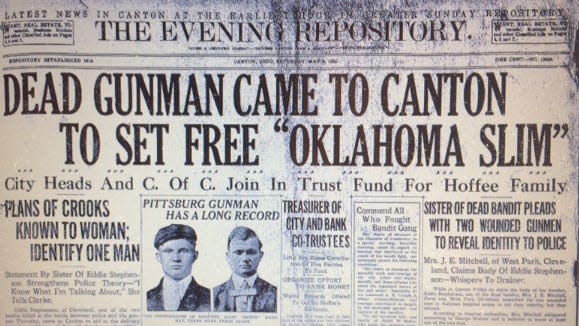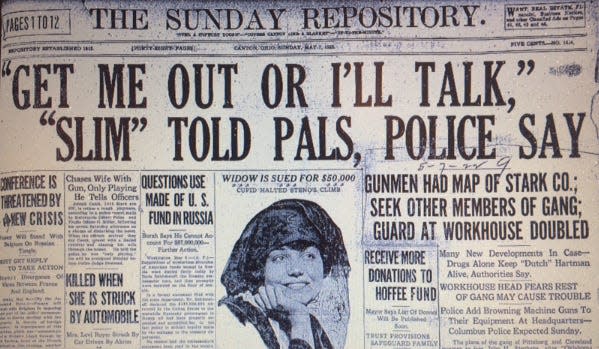The Monday After: Solving the mystery of 'Oklahoma Slim'

The drama surrounding the notorious "Oklahoma Slim" came to life a century ago with what The Evening Repository called the "Worst Gun Clash In Canton's History."
A tale of "Oklahoma Slim" begins the day in March 1922 when a man identified as John Hager Stephens, 29, of Parkersburg, West Virginia, reported to be "one of the most notorious bandits in the country," was arrested by Canton police in a house on Tuscarawas St. W.
"Canton police have been following out 'tips' and clues for the apprehension of Stephens for more than a year," said a front-page article in The Evening Repository on March 29, 1922. "He has a long criminal record and is believed to be one of the most desperate criminals ever apprehended in Canton.
"Local police authorities say they believe he was impicated in a number of safe jobs in Canton, as well as the robbery of the post office at Hartville a few weeks ago, and other post office jobs over the state. Stephens traveled under the aliases of Slim Hager, Oklahoma Slim, George Martin, George Reed, and Gabe, they say."
Stephens had a cocked revolver in his pocket when police burst in on him, the newspaper said, and "officers believe that he would have made some resistance had there not been three of them present."

Slight chance of Slim squealing
Stephens at first refused to talk to police. Within a day, however, he was bragging to Canton police that they should tell law enforcement officials in Parkersburg, West Virginia, that he was the man they had been searching for since he and two others had pulled a post office robbery there in 1914. His accomplices were doing time. Hagar had jumped bail.
The man known to Repository readers as "Oklahoma Slim" threatened to sing some more and implicate others, according to a bold, banner headline in the Repository early in May.
"'GET ME OUT OR I'LL TALK,' 'SLIM' TOLD PALS, POLICE SAY."
And gang members did come to the Canton area to spring "Oklahoma Slim" from the Stark County Workhouse, Repository accounts later reported.
"GUNMEN CAME HERE TWO WEEKS AGO TO PLAN ESCAPE OF 'SLIM'," said a headline in the newspaper on May 8, 1922, only days after gang members were involved in a deadly gun battle.
Five men would die in the hail of bullets on May 5, 1922, or in the days following it, including the four gang members.
Gunfight was north of city
"GUN BATTLE RAGED FOR HOUR ON STARK FARM," a Repository headline said on Friday, May 5, 1922, the day after police and a posse chased down the bandits. That farm off 55th Street NW in Plain Township, owned then by Obed Oberlin, included the grounds on which Gervasi Vineyard now is located.
Two men were killed, three were seriously wounded and two others less seriously hurt late in the afternoon of Thursday, May 4, 1922, in a gun battle "between city police and citizens and an automobile gang of alleged bandits."
"Police authorities say they believe that the gang had come to Canton to aid John H. Stephens, alias 'Oklahoma Slim,' to escape from the county workhouse," the newspaper reported. "Authorities base their conclusion upon the fact that the bars on Stephens' cell at the workhouse were found sawed Wednesday and a bundle containing a revolver and clothing, with Stephens initials on it, were found in the bottom of the gunmen's machine (car)."
Law enforcement officials believed that the bandits were part of the Losteiner Gang, which was a band of well known lawbreakers at the time.
"The battle followed a chase by Canton police and citizens of the four alleged bandits after the latter had kidnapped motorcycle officer John Wise and had fled with him north of the city," the Repository reported. "When the bandits saw that the police were overtaking them they abandoned their car, taking Wise with them and bound and gagged him in the woods about five miles north of the city."
Shots were exchanged between the posse and the fugitives. When one of the bandits was dropped by bullets, Wise was abandoned by the fleeing remainder of the gang.
"One of the bandits was apparently crippled and his companions made a stand behind a clump of grees and started firing. The battle between the posse and the gunmen continued for about an hour."
Death list grew over following days
Killed in the gunfire was Ralph W. Hoffee, 28, of Canton, a contractor who was a member of the posse.
Less seriously wounded were Patrolman Jesse Vogley of Canton, who was shot in the right leg, and Robert Bostin, a member of the posse who was hit in the left foot.
Also killed was a bandit who was unidentified at the time, but was believed to be Willie Mitchell of Cleveland. Eddie Stephenson, 32, "a notorious robber and bandit," died later at a hospital.
Two other bandits, Harry Harpert, 30, of Cleveland's west side, believed to be the leader of the gang, and George Brainer of Buffalo, New York, both were shot in the head and, according to the newspaper account, "probably will die."
Indeed, both bandits did die from their wounds, but not before he and the gang members confessed to a spree of violent crimes, including the robbery of a bank in Grafton, Pennsylvania, and the killing of a cashier during that crime.
And then, it got weird.
More than one 'Oklahoma Slim'
Aided by a woman who visited them, police learned that Harpert and Brainer were not who they appeared to be at the time of the gunfight. They were Andy Kapler and Jimmy Blake, who had come to Canton two weeks before the gunfight, and tried to make arrangements for delivery of a package – perhaps the gun and clothes – to "Oklahoma Slim."
"Police believe that Kapler, who is also known as 'Dutch' Hartman, and Blake were among the yeggs who had been threatened through word said to have been sent out by 'Oklahoma Slim' through underground channels from the workhouse," reported the Repository.
Blake, who besides being known to some as George Brainer and Tom Lundy, also used the alias Jimmy Saxon. He turned out to be named Tommy Saxon.
Confused yet? Police were, for a time. And it got worse before it all got cleared up.
Who was the real Oklahoma Slim?
What of Oklahoma Slim at the workhouse? It turns out he was only one of a trio who were known by that name. And his real name was Norman Warden, not John Hager Stephens.
The real John Hager Stephens was the initially unidentified bandit at the scene of the shootout. His body was identified by his mother when she came to Canton on May 10.
"With the identification of Stephens Wednesday night police say it has been established that there were three men traveling under the alias of 'Oklahoma Slim,' " reported the Repository on May 11, 1922. "The original 'Oklahoma Slim' is now serving time in a western penitentiary, while Norman Warden at the Stark County workhouse and the dead bandit, also used the same alias."
One of the most fascinating and often-repeated crime stories of Canton history, by the way, concerns the fate of the body of the bandit named Kapler. According to an article written by the Repository's Tim Botos in 2015, he was not buried. He was displayed.
"Kapler’s body was heavily embalmed – mummified – at the former Hiller Funeral Parlor in Canton. Since no relative claimed him, his mummy was placed on public display at the parlor," Botos wrote. "It remained there for several years until it was sold to a sideshow operator in San Francisco. The mummy later was sold to a collector before it ultimately was donated to the Smithsonian in 2003."
Reach Gary at gary.brown.rep@gmail.com. On Twitter: @gbrownREP.
This article originally appeared on The Repository: The Monday After: Solving the mystery of 'Oklahoma Slim'
